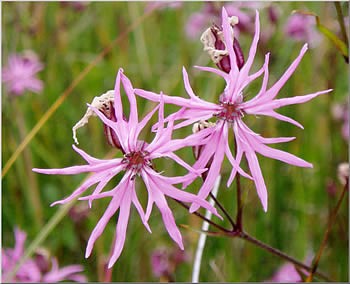
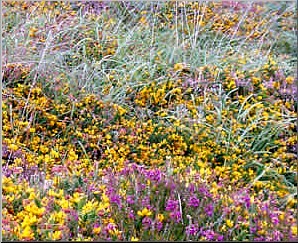
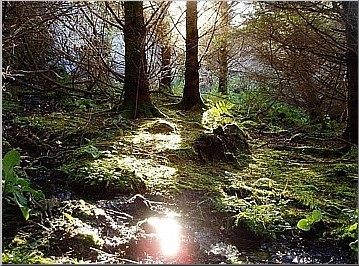
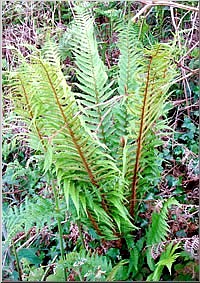
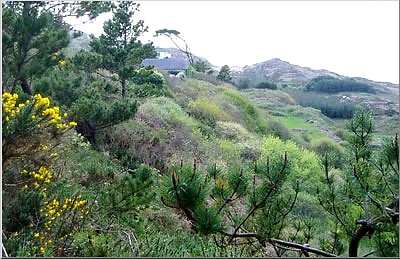
Deciduous scrub
Thickets of goat willow, brambles, bracken and holly provide shelter, food and nesting sites for songbirds.
Blackbirds, robins, chaffinches, and tits abound in spring, tiny warblers can be heard rather than seen, and the thrush turns up the volume of its beautiful song when a storm is approaching.
Foxes also use the thickets for cover.
Pasture
This includes lush grasses, rushes, buttercups and sorrel, good summer grazing for the cattle.
Choughs and ravens overfly the pasture, in spring the ravens loop the loop down the stepped terrain, apparently just for fun!
In August spectacular dragonflies zoom back and forth like military helicopters, and in autumn snipe and curlew are seen.
Blue sheepsbit scabious and magenta knapweed are colourful in the drier areas, the lawn is grazed by hares, early morning or late evening is the best time to see them.
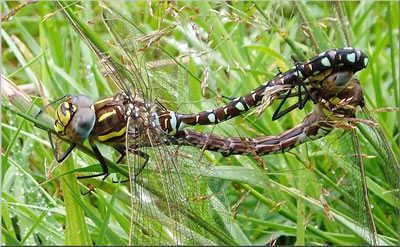
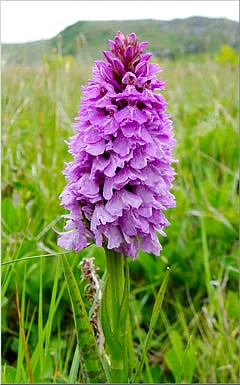
The less grazed areas have spotted orchids and large pink marsh orchids
The old stone walls beautifully display the variety of local stone, and are home to mosses, ivy, ferns, lizards and mice, also popular nesting places for busy wrens and blue tits.
Old hay meadows
The variety and colour of the wild flowers in June and July is amazing, and also contributes to wonderful honey!
Wild flowers include hawkweeds, red clover, ox-eye daisy, yellow bartsia and hay rattle.
Many meadow butterflies feed here, including the green hairstreak and various browns and blues.



Streams and ditches
After heavy rain the usually gentle stream may be up to a metre deep; it emerges in various places in the top woodland, such as the 'water curtains' , then rushes across the meadow, and thunders down the long waterfall.
The stream banks and ditches are brilliant with summer wild flowers, including purple loosestrife, water forget-me-not, meadow sweet, water mint, angelica and greater birdsfoot trefoil.
Some interesting ferns are found here too, in particular the beautiful Royal Fern, a native of this area.
Frogs live in the ditches - the heron patrols in spring when they are spawning,
Otters also visit for the occasional snack. We once found a freshwater eel in the stream.
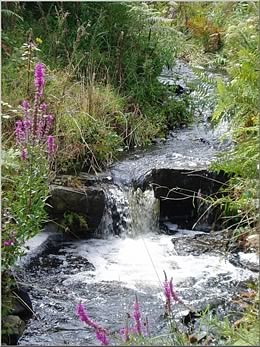
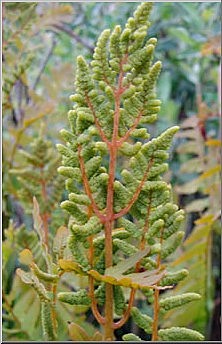
Steep rockfaces
These are some of the most interesting places to look for plants.
The damp rocks are colonised by St Patrick's Cabbage, a saxifrage almost identical to London Pride, and a variety of mosses, ferns, and liverworts.
Snowy woodrush, violets, bugle, Irish ivy, bluebells, primroses, bilberry, foxgloves, hazels, and white oaks grow on the shady slopes.
The more open rocks are colonised by with heathers and gorse and you can also find golden rod, yellow burnet rose and the striking Irish spurge.
This latter, along with St Patrick's Cabbage, are "Lusitanian" plants originating from the time when Ireland was joined to Brittany, Spain and Portugal.
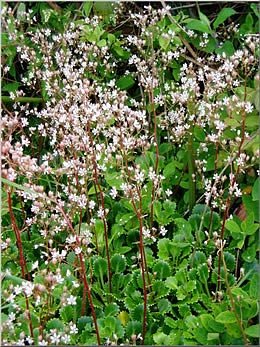
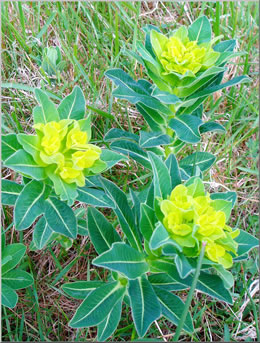
Lack of farming for many years, allowing longer-term vegetation to establish, has produced an exceptional variety of habitats on these 36 acres.
The sheep and cattle grants of the past led to heavy grazing in many surrounding areas; the farm is a rare haven for plants and wildlife on this exposed tip of land.
We are in the A.E.O.S Natura Scheme which helps farmers preserve, maintain and improve habitats and historic farmland features.
This requires low stocking rates and designated habitat areas.
Our farm animals help to maintain the grassland areas, the cattle have done a grand job barging their way into unexplored places.
Habitats here include:
Dry heathland developed on blanket bog
Large areas are covered by heathers and Irish gorse, vivid purple and gold in August and September, and as beautiful in winter and spring with moor-grass bleached pale gold and the French Gorse in flower.
The gorse is alive with the songs of nesting birds in spring, stonechats, siskins, blackcaps and goldfinches being the most common.
A pair of merlins have nested here, these birds being part of their diet! From our steep slopes, you can watch them hunting below.
The farm is also the regular hunting ground of kestrels, and peregrines and hobbies have also been spotted.
Coniferous woodland
Twenty thousand trees were planted here some twenty years ago, in wide informal belts; largely Monterey pines and Sitka spruce plus a few larches and Nordman firs.
They blend beautifully with the heathland; providing shelter, firewood, weedfree walkways beneath, of great value to roosting birds, and much visited by flocks of small birds such as long-tailed tits, crossbills and goldcrests.
A pair of long-eared owls have nested here; at dusk you may see them patrolling, dark shapes zig-zagging the lower fields .
This is the first shelter for birds blown West in Atlantic storms, so it's worth watching for accidental visitors.
The floor of the conifer woodland is studded with a variety of bright evergreen ferns, a beautiful sight when the sun streams through the branches.
|
|